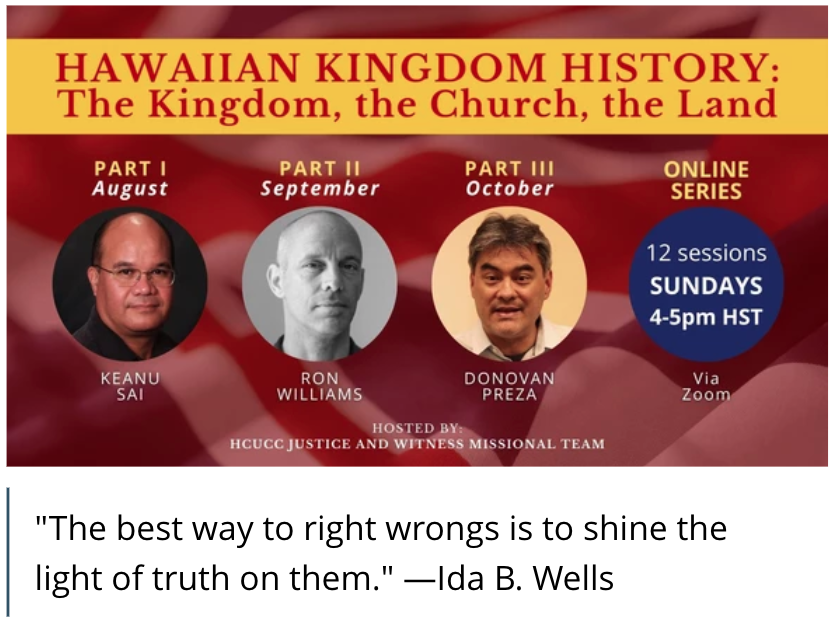
Come join the HCUCC Justice and Witness Missional Team for this exciting and informative exploration of Hawaiian History. Whether you are kamaʻāina or a relative newcomer to Hawaiʻi, you will hear history that you have not heard before.
Three eminent scholars, Dr. Keanu Sai, Dr. Ron Williams Jr., and Donovan Preza, will help us delve into historic documents and events that can inform us as we seek understanding and discernment regarding fulfilling our promise made in the UCC’s apology 30 years ago to the Hawaiian people to stand with them in seeking justice.
See and hear newly translated church documents from over a century. Learn about the Hawaiian Kingdomʻs founding and continuing legal status under International law. Learn about the Mahele and privatization of Hawaiian land under Hawaiian Kingdom law and why land issues will continue unless the UCC promise is fulfilled. Learn about churches who actively resisted the overthrow of the Hawaiian Kingdom, and the white oligarchy who facilitated the illegal overthrow. If as brothers and sisters in Christ we desire reconciliation, we must first acknowledge the nature of the wrongs and their continuing effects on these islands, the Hawaiian people, and our Church.
This 12-week series will be presented through Zoom beginning on Sunday, August 7, 2022, at 4:00 p.m. HST and continues each Sunday, at the same time, through October 23, 2022. Each Zoom session will be one hour long consisting of a presentation followed by questions and discussion.
To attend any or all of the sessions, please register HERE.
PART I: The Kingdom
Presenter: Dr. Keanu Sai
ABOUT THE PRESENTER: I have a Ph.D. in Political Science specializing in Hawaiian Constitutionalism and International Relations, and a founding member of the Hawaiian Society of Law & Politics. I served as lead Agent for the Hawaiian Kingdom in arbitration proceedings before the Permanent Court of Arbitration at The Hague, Netherlands, from November 1999-February 2001. I also served as Agent in a Complaint against the United States of America concerning the prolonged occupation of the Hawaiian Kingdom, which was filed with the United Nations Security Council on July 5, 2001. Articles on the status of the Hawaiian Kingdom as an independent state, the arbitration case and the complaint filed with the United Nations Security Council have been published in the following journals: American Journal of International Law, vol. 95 (2001); Chinese Journal of International Law, vol. 2, issue 1, (2002), and the Hawaiian Journal of Law & Politics, vol. 1 (2004).
- AUGUST 7 Hōʻike ʻEkahi (Presentation 1) The importance of terminology. Is Hawaiian a nationality, which is multi-ethnic, or a native indigenous people that have been colonized by the United States?
- AUGUST 14 Hōʻike ʻElua (Presentation 2) The constitutional history of the Hawaiian Kingdom from King Kamehameha III to Queen Lili‘uokalani (1839-1893)
- AUGUST 21 Hōʻike ʻEkolu (Presentation 3) The illegal overthrow of the government of the Hawaiian Kingdom and the continued existence of the Hawaiian Kingdom as a State under international law
- AUGUST 28 Hōʻike ʻEhā (Presentation 4) The road to recovery of ending the American occupation. How to bring compliance to the rule of law in light of war crimes and human rights violations committed in the Hawaiian Kingdom since January 16, 1893
PART II: The Church
Presenter: Dr. Ronald Williams Jr.
ABOUT THE PRESENTER: Dr. Ronald Williams Jr. holds a doctorate in history from the University of Hawaiʻi at Mānoa with a specialization in Hawaiʻi and Native-language resources. He is a former faculty member of the Hawaiʻinuiākea School of Hawaiian Knowledge, UH Mānoa and in 2017 was the founding director of the school’s Lāhui Hawaiʻi Research Center. Dr. Williams is also a past president of the 128-year old Hawaiian Historical Society. He currently works as an archivist at the Hawaiʻi State Archives and serves as Hoʻopaʻa Kūʻauhau (Historian) for the grassroots political organization Ka ʻAhahui Hawaiʻi Aloha ʻĀina. Dr. Williams was a contributing author to the 2019 Samuel Manaiākalani Kamakau Book of the Year award-winning publication, Hoʻoulu Hawaiʻi: The Kalākaua Era. He has published in a wide variety of academic and public history venues including the Oxford Encyclopedia of Religion in America, the Hawaiian Journal of History, and Hana Hou! Magazine.
- SEPTEMBER 04 Hōʻike ʻEkahi (Presentation 1) The Early Mission, 1820 -1863
- SEPTEMBER 11 Hōʻike ʻElua (Presentation 2) Hōʻeuʻeu Hou: Sons of the Mission and the Shaping of a New “Mission,” 1863-1888
- SEPTEMBER 18 Hōʻike ʻEkolu (Presentation 3) Poʻe Karitiano ʻOiaʻiʻo (True Christians)
- SEPTEMBER 25 Hōʻike ʻEhā (Presentation 4) “I ka Wā Mamua, ka Wā Mahope” (The Future is in the Past)
PART III: The Land
Presenter: Donovan Preza MORE INFO TO COME
- OCTOBER 2 Hōʻike ʻEkahi (Presentation 1)
- OCTOBER 9 Hōʻike ʻElua (Presentation 2)
- OCTOBER 16 Hōʻike ʻEkolu (Presentation 3)
- OCTOBER 23 Hōʻike ʻEhā (Presentation 4)
